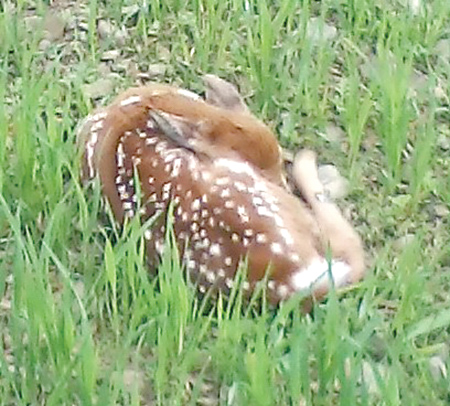Well, it’s that time of year when we need a gentle reminder. And the reminder is that Mother Nature has things well in hand and doesn’t need interference by well-intended humans. I refer to the fact that in the next several weeks young of all kinds will come into this world — from baby birds to those oh-so-cute fawns with their big brown eyes and beautiful white spots!
All of these magnificent young birds and mammals are wonderful to observe but need to be watched from a distance. If you get too close, the newly born or weeks old young can panic — causing young birds to drop from a nest or young mammals to flee from their hiding spot and put themselves in danger of predation. Take photographs if you want, but do so from a distance so as not to put the subjects in danger.
Probably the most encountered young of any species is the fawns of the whitetail deer. Their birth is underway and will continue for several more weeks. Spring gobbler hunters, or those folks just out for a hike, will have good odds of spotting one of these young deer — usually curled up and lying still to avoid predation. During the initial phase of a newly born fawn’s life, it has no scent. This helps prevent predation during this early phase while it develops the strength in its legs to (hopefully) outrun any predators that cross its path. By the time it develops its scent, it should have the strength and stamina to outrun anything that is looking at it for its next meal.
From fishers to bobcats to coyotes and from bald eagles and golden eagles to the mighty black bear, there are an amazing number of predators that will be happy to come across an unsuspecting fawn. Indeed, the doe that gave birth to them is a powerful adversary when protecting her newly born fawn, but from time to time she will leave her newborn to feed to maintain her strength and enforce her milk supply. During these times, the fawn’s greatest method of avoiding predation is to curl up, often in tall grass, and remain as motionless as possible — allowing its light brown color, with white spots to help it blend in with its surroundings and go undetected.
Among all of its predators, the black bear takes more fawns every spring than any of the others do. This is a fact that many have difficulty accepting, but studies here in Pennsylvania, and in other states support that fact. For those of you who spend time in the outdoors, you may have wondered why you have more black bear sightings this time of year. It is because they are out cruising fields and woodlots in search of fawns, and they will do so in daylight hours as well as nighttime.
On more than one occasion I have witnessed this bear activity. Several seasons ago, I watched two large (about 300 pounds each) bears slowly sauntering across a fallow grass field, staying about 40 to 50 yards apart as they cased their path in search of a fawn. I often wondered just how friendly or sharing they would be if their joint efforts produced a fawn and they were subjected to possibly sharing their discovery. Additionally, I recall sleeping with my window open and rapidly sitting up in bed as I was awakened to the loud cry of a fawn in the early morning darkness as a bear must have discovered it. The thought of what must have been happening was not pleasant, but it was the reality of a typical act in nature.
So what should one do if you came across a fawn in the wild? First, realize that it is NOT abandoned. There is little doubt that the mother is nearby — hiding and watching you from a safe distance. Once you leave, she will return to feed and care for her young. So, enjoy watching for a few moments, take pictures if you want, but don’t stay too long and don’t get too close. The last thing you want to do is frighten the fawn from its bed only to spotted by a nearby predator!
If, on the infrequent and unusual occasion that you know for certain that the mother has been seriously injured or killed, contact the Pennsylvania Game Commission office in Jersey Shore, at (570) 398-4744, explain the situation and ask for the contact information of a nearby licensed wildlife rehabilitator.





Leave a Comment
Your email address will not be published. Required fields are marked with *